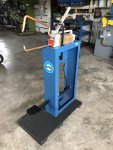PILOON
Well-known member
In my late teens I was always into electricity and basic electronics.
Browsing a surplus store I found a stepdown transformer that reduced very high voltage down to 110 AC and had an easy frame design.
Bought it, counted the 110 windings (88 turns) and duplicated them to get 220 input.
For my secondary I used 1/4 inch copper tubing and tightly wound (55 or so turns) for my secondary and re assembled the transformer.
For insulation I poured urathane varnish all over my creation.
Hooked up my creation to 220 and nothing blew up, LOL.
My very first welds were accomplished with 2 prs of vice grips, one as the ground and the second gripping a 1/8 rod wearing a heavy leather glove.
Well sparks flew and a weld was produced!
I crudely boxed it in plywood and had me a DIY welder.
Later I crudely calculated (by style of rods and fuses not blown etc) that my creation could put out somewhere in the 180 amp range.
I've since played around and made a few DIY welders. A favorite small capacity can be made using fairly common 110/24 volt i25 amp industriel units by adding some windings on the 24 volt output side if space is available. Now striking an arc is tricky (low voltage) and very small rods kind of rare but it will work.
Another successful DIY was made from a discarded HD garage booster/charger that a neighbor was scrapping. That one merely wanted a few extra windings on the output side.
Naturally precautions are necessary, like respecting fusing/wire guides and common safety rules working around electricity.
OH, and today I have a Hobart 220 and a small 'el cheapo' wire spool machine.
Never took welding courses but years of DIY projects has me being a fair welder.
At least I can brag that my projects don't fail. (well rarely)
Browsing a surplus store I found a stepdown transformer that reduced very high voltage down to 110 AC and had an easy frame design.
Bought it, counted the 110 windings (88 turns) and duplicated them to get 220 input.
For my secondary I used 1/4 inch copper tubing and tightly wound (55 or so turns) for my secondary and re assembled the transformer.
For insulation I poured urathane varnish all over my creation.
Hooked up my creation to 220 and nothing blew up, LOL.
My very first welds were accomplished with 2 prs of vice grips, one as the ground and the second gripping a 1/8 rod wearing a heavy leather glove.
Well sparks flew and a weld was produced!
I crudely boxed it in plywood and had me a DIY welder.
Later I crudely calculated (by style of rods and fuses not blown etc) that my creation could put out somewhere in the 180 amp range.
I've since played around and made a few DIY welders. A favorite small capacity can be made using fairly common 110/24 volt i25 amp industriel units by adding some windings on the 24 volt output side if space is available. Now striking an arc is tricky (low voltage) and very small rods kind of rare but it will work.
Another successful DIY was made from a discarded HD garage booster/charger that a neighbor was scrapping. That one merely wanted a few extra windings on the output side.
Naturally precautions are necessary, like respecting fusing/wire guides and common safety rules working around electricity.
OH, and today I have a Hobart 220 and a small 'el cheapo' wire spool machine.
Never took welding courses but years of DIY projects has me being a fair welder.
At least I can brag that my projects don't fail. (well rarely)

